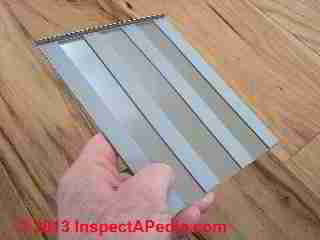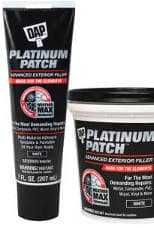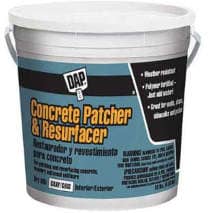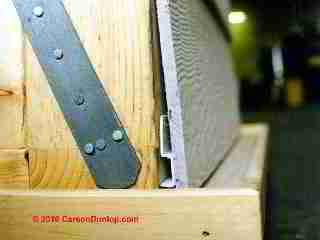 Fiber Cement Siding Maintenance
Fiber Cement Siding Maintenance
How to protect fiber cement siding from water & weather damage
- POST a QUESTION or COMMENT about the cause & cure of butt joint gaps in fiber-cement siding & about fiber cement siding installation
Fiber cement siding maintenance recommendations from Certainteed™, James HardiePlank™ & other sources.
This article describes steps to protect building siding from water damage, plant damage, weather damage in general, giving clearances as well as sealing & caulking advice. We include sources for back flashing and H flashing that can be retrofitted to leaky or loose building siding to improve its weather resistance. Page top photo: Tamlyn's back flashing product recommended when lap siding was installed.
InspectAPedia tolerates no conflicts of interest. We have no relationship with advertisers, products, or services discussed at this website.
- Daniel Friedman, Publisher/Editor/Author - See WHO ARE WE?
Manufacturer's Advice for Maintaining & Protecting Fiber Cement Siding [CertainTeed & JamesHardie]
Adapted & excerpted from CertainTeed Corporation's "CertainTeed WeatherBoards™ Fiber Cement Siding Installation Manual" [5a] and from "Fiber Cement Siding Best Practices for Effective Job Site Management"[5b] and from JamesHardie Corporation installation instructions and bulletins for JamesHardie HardiePlank lap siding. [12][12b]
Moisture Management and Gutters & Fiber Cement Siding Avoids Water Damage
Water management is key to protecting every part of your home, including your siding. Each area of the country is affected by moisture, whether it’s an occasional thunderstorm, high levels of rainfall or heavy snow accumulations.
The resulting moisture has potential to cause damage if not managed effectively. We recommend protecting your home from rainfall with gutters and downspouts. Divert or remove heavy snow accumulations that may stand against the siding for extended periods of time. And you should always be sure that your drainage system is free of debris and working properly.
Details: See
- GRADING, DRAINAGE & SITE WORK
- GUTTERS & DOWNSPOUTS - No. 1 on the home inspector's hit parade of sources of water where we don't want it.
- FIBER CEMENT SIDING PAINTS - specific advice for painting fiber cement siding & for diagnosing paint failures on fiber cement lap siding installations
- SIDING DAMAGE by SPLASHBACK - a more severe problem where wood siding products are installed
- SIDING WOOD, FLASHING DETAILS - contains siding flashing details that work well for fiber cement and some other siding products as well
Shrubbery & Fiber Cement Siding, Recommended Distances
Proper moisture management also involves managing your landscape. Plants hold moisture, so any trees or shrubs that are close to your home should be trimmed periodically. Plants should not come into contact with your siding. Also, sprinkler systems should be adjusted to not saturate areas near your home.
- Details: see TREES & SHRUBS, TRIM OFF BUILDING and also see ALGAE, FUNGUS, LICHENS, MOSS.
Clearances for Fiber Cement Siding to Ground, Walks, Patios, Shrubs
Maintain required clearances and drainage slopes to ensure that moisture is diverted away from your siding at roof lines and ground level. Proper clearances include 1 inch from concrete, roof lines, patios, etc., and 6 inches from the finished grade. Landscaping should not reach the siding.
This refers to clearances from siding lower edge to ground, horizontal clearances to shrubs, &c. For details about siding gaps and clearances to other building components see Certainteed WeatherBoard fiber cement siding gap & caulking specifications
Re caulking Fiber Cement Siding - vs Installing H-Covers to Cover Siding Butt Joint Gaps
It is normal for building products located on the exterior of a home to expand and contract with temperature changes. To ensure a successful siding installation, you must allow for this movement during installation.
While CertainTeed WeatherBoards Fiber Cement siding does not experience the same rate of expansion and contraction as many other building products (such as wood), over time you may notice movement of the siding, specifically at the butt end/joints. This issue is mainly an aesthetic issue and should not create a condition that would cause long-term product failure. If you are dissatisfied with the appearance of the butt end/joint locations and wish to address them, CertainTeed recommends that you apply H-covers at the joint locations.
You will see vertical lines where each H-cover is installed, but then in our OPINION there were vertical lines already visible at the butt joint. And we agree with CertainTeed that this approach is likely to be more attractive than blobbing or smearing caulk into butt joint openings - a procedure that changes the texture of the siding and its coating performance or re-painting performance and appearance in a way that can be far more ugly, leaving roundish smears at every butt joint so treated.
Watch out: even the H-cover solution to siding board butt joint gaps is not without possible trouble. What are the chances that the plastic or aluminum of the H-cover will weather and change color at the same rate and in the same hue as the paint or coating on the siding boards? I'll bet zero. So over time these covers may become more noticeable.
Details about cures for the cosmetic problem of gaps at lap siding butt joints as well as for wall leaks at these locations are found at SIDING, FIBER CEMENT GAP CURES.
Question: how to fill holes, chips, dents in Fiber Cement Siding
 2019/10/04 Jackie H. Smith said:
2019/10/04 Jackie H. Smith said:
The Hardie Board siding was gouged in a deep, about 4-inch angular shape where the siding just had to be picked out. Home Depot employees suggested a cement material, which my husband used. When it dried, he sanded it with an electric sander. When it dried it looked like you would expect cement to look, rough.
It is on the back of the house and it will be painted to blend with the dark blue of the house. The only time that will be a problem will be if we should ever sell the house.
Is there a product for use with Hardie Board siding that would have worked better? The siding is smooth reverse board and batten style. Thanks.
Reply:
Thanks for an interesting question, Jackie.
OPINION: If this is a single-event, single point of damage on the home and if this is the biggest concern expressed by your home buyer we ought to be elated as it's certainly of no consequence: it's a minor cosmetic concern, not something indicative of a greater problem.
James Hardie, the makers of Hardie Board, noting that the siding is a cement board product, recommend patching damaged areas such as that you describe by using an acrylic mortar patching compound.
I'd like to know the specific product your husband used and I'd like to see a photo of the damaged / repaired area. You can post one photo per comment but of course can post as many comments and photos as you like.
There is a plethora of patching compounds on the market including cemetious ones and plaster-based patches. An example product from DAP and described as recommended for FC siding is shown below.
Here is an excerpt from what JamesHardie says about patching their Fiber Cement Siding
Fiber Cement Siding Repair or Patching
 Re-applying caulking when it has begun to show signs of wear can help keep moisture from getting into the wall cavity. These areas include, but not limited to, penetrations, flashings, plank and trim connections, and in some cases, between plank joints.
Re-applying caulking when it has begun to show signs of wear can help keep moisture from getting into the wall cavity. These areas include, but not limited to, penetrations, flashings, plank and trim connections, and in some cases, between plank joints.
NOTE: James Hardie recommends the use of caulks and sealants that remain permanently flexible. Look for the words “permanently flexible” written clearly on the label or in the accompanying literature. For best results, use an Elastomeric Joint Sealant complying with ASTM C920 Grade NS, Class 25 or higher, or a Latex Joint Sealant complying with ASTM C834.
Caulking/sealant must be applied in accordance with the caulking/sealant manufacturer’s written instructions or ASTM C1193.
Dents, chips, cracks and other minor surface damage in James Hardie siding and trim products can be filled with cementitious patching compound.
Refer to manufacturer’s recommendations for products that are compatible with fiber cement. [Emphasis ours - Ed.] - James Hardie Corp. retrieved 2091/10/04 original source: www.jameshardie.com/product-support/resource-center/fiber-cement-siding-maintenance
See details at SIDING, FIBER CEMENT BOARD REPAIRS
or for minor re-caulking repairs
see SIDING, FIBER CEMENT GAP & CAULK SPECS
...
Continue reading at SIDING, FIBER CEMENT BOARD REPAIRS or select a topic from the closely-related articles below, or see the complete ARTICLE INDEX.
Or see these
Recommnded Articles
- SIDING, FIBER CEMENT
- CERTAINTEED WeatherBoards™
- CHINESE fiber cement siding
- FIBER CEMENT SIDING PAINTS
- FIBER CEMENT SHINGLE CUTTING TOOLS
- FIBER CEMENT SHINGLE REPAIRS
- JAMES HARDIEPLANK® FC SIDING
- NICHIHA ™ FIBER CEMENT SIDING FIELD REPORT
- SIDING CLEARANCE TO GROUND
- SIDING FIBER CEMENT COEFFICIENTS of EXPANSION
- SIDING, FIBER CEMENT CURL / LIFT DEFECTS
- SIDING, FIBER CEMENT DEFECTS - home
- SIDING, FIBER CEMENT DEFECT DIAGNOSTIC QUESTIONS
- SIDING, FIBER CEMENT GAP & CAULK SPECS
- SIDING, FIBER CEMENT GAPS
- SIDING, FIBER CEMENT GAP CURES
- SIDING, FIBER CEMENT IDENTIFICATION
- SIDING, FIBER CEMENT MAINTENANCE
- SIDING, FIBER CEMENT MOISTURE ABSORPTION
- SIDING, FIBER CEMENT MOISTURE LEVELS
- SIDING, FIBER CEMENT REMOVAL
- SIDING, FIBER CEMENT BOARD REPAIRS
- ASBESTOS & FIBER CEMENT ROOFING - home
- FIBER CEMENT PRODUCT MANUFACTURERS
- FIBER CEMENT PRODUCT STANDARDS
- FIBER CEMENT ROOF SHINGLE ASBESTOS TEST RESULTS
Suggested citation for this web page
SIDING, FIBER CEMENT MAINTENANCE at InspectApedia.com - online encyclopedia of building & environmental inspection, testing, diagnosis, repair, & problem prevention advice.
Or see this
INDEX to RELATED ARTICLES: ARTICLE INDEX to BUILDING SIDING
Or use the SEARCH BOX found below to Ask a Question or Search InspectApedia
Ask a Question or Search InspectApedia
Questions & answers or comments about the cause & cure of butt joint gaps in fiber-cement siding.
Try the search box just below, or if you prefer, post a question or comment in the Comments box below and we will respond promptly.
Search the InspectApedia website
Note: appearance of your Comment below may be delayed: if your comment contains an image, photograph, web link, or text that looks to the software as if it might be a web link, your posting will appear after it has been approved by a moderator. Apologies for the delay.
Only one image can be added per comment but you can post as many comments, and therefore images, as you like.
You will not receive a notification when a response to your question has been posted.
Please bookmark this page to make it easy for you to check back for our response.
Comments
IF above you see "Comment Form is loading comments..." then COMMENT BOX - countable.ca / bawkbox.com IS NOT WORKING.
In any case you are welcome to send an email directly to us at InspectApedia.com at editor@inspectApedia.com
We'll reply to you directly. Please help us help you by noting, in your email, the URL of the InspectApedia page where you wanted to comment.
Citations & References
In addition to any citations in the article above, a full list is available on request.
- James Hardie Fiber Cement Siding Best Practices, Appendix A, (2014) [PDF] available from James Hardie Corporation, 231 S. LaSalle St., Suite 2000
- [1] "James Hardie's Mesothelioma and Asbestos Legacy Continues, 2009", web search 03/01/2011, www.survivingmesothelioma.com
- [2] Killer Company, James Hardie Exposed, Matt Peacock, Harper Collins Australia, ISBN: 9780733325809; ISBN10: 0733325807
- [3] " Anyone else have HardiePlank siding on their house?", Early Retirement.org online blog, retrieved 1/14/2013, original source: http://www.early-retirement.org/forums/f27/anyone-else-have- HardiePlank-siding-on-their-house-19475.html
- [4] - DIY Chatroom, retrieved 1/17/2013, original source http://www.diychatroom.com/f2/ certainteed-weatherboard-vs-HardiePlank-4638/
- [5] Certainteed Weatherboard fiber cement siding and trim products - see certainteed.com/ or see certainteed.com/resources/sidingandtrimspecsheet.pdf
- [5a] "CertainTeed WeatherBoards™ Fiber Cement Siding Installation Manual", CertainTeed Corporation, 2012, CertainTeed Corporation, PO Box 880, Valley Forge PA 19482, Professional Help Line: 800-233-8990, Consumer Help Line: 800-782-8777, Website: Certainteed.com www.certainteed.com/resources/fc017.pdf retrieved 4/11/2013, [copy on file as Certainteed_Fiber_Cement_Siding_Install_fc017.pdf ]
- [5b] "Certainteed WeatherBoards™ Fiber Cement Siding Best Practices for Effective Job Site Management", CertainTeed Corporation, retrieved 4/15/13 original source: www.certainteed.com Copy on file as Certainteed_FC_Handling Brochure-Contractor_FC063.pdf
- [6] "Moisture Control in buildings: Putting Building Science in Green Building," Alex Wilson, Environmental Building News, Vol. 12. No. 5. [Good tutorial, "Moisture 101" outlining the physics of moisture movement in buildings and a good but incomplete list of general suggestions for moisture control - inadequate attention given to exterior conditions such as roof and surface drainage defects which are among the most-common sources of building moisture and water entry.--DJF]
- [7] J. Tibbets, "Green Houses", NCBI, retrieved 1/17/2013, original source: http://www.ncbi.nlm.nih.gov/pmc/articles/PMC1469482/
- [8] Gleeson et al, "Fiber Cement :Building Materials with Low Density Additives", U.S. Patent 8,182,606, B2 5/22/2012, [adding low volumes of volcanic ash & hollow ceramic microspheres to cellulose fiber-reinforced building materials.
- [9] Thanks to reader Marie Carr for James HardiePlank siding photograph and case history information. 06/01/2008
- [10] JamesHardie HardiePlank® Lap Siding information can be found at the company's web page on this material:
https://www.jameshardie.com/products_siding_hardieplankLapSiding.py - [11] "30-Year Limited Warranty
HardiePlank® HZ5® Lap Siding, HardiePanel® HZ5® Vertical Siding,
HardieShingle® HZ5® Siding, HardieSoffit® HZ5® Panels", 1-800-9-HARDIE
10901 Elm Avenue Fontana, CA 92337, retrieved 1/18/2013, original source: https://www.jameshardie.com/pdf/warranty/hz5.pdf [copy on file as Hardieplank_Warranty_hz5.pdf] - [12] James Hardie Building Products, James Hardie CustomerLink™ Service Centre, 10 Colquhoun Street, Rosehill NSW 2142, Tel: 13 1103, Outside Australia 61 2 8837 4709,
Fax: 1 800 818 819. Hardie has operations in Australia, Asia, Canada, Europe, New Zealand, United States, and the Philippines. The company is a significant producer of fiber cement siding and backerboard. Email: info@JamesHardie.com and Website https://www.jameshardie.com/
- JamesHardie Corporation, in the U.S. can be contacted at 26300 La Alameda, Suite 400,
Mission Viejo, California 92691 -
1-888 J-HARDIE
1-888 542-7343 or by email to info@JamesHardie.com - [12b] "Technical Bulletin #9, Joint Flashing at Field Butt Joints", JamesHardie, retrieved 4/15/2013, original source: www.jameshardie.com, copy on file as James_Hardie_9-joint-flashing.pdf - quoting:
This Technical Bulletin is an explanation supporting the announcement made by James Hardie on September 8th, 2008 withdrawing its recommendation on the use of caulk at field butt joints for HardiePlank® lap siding.
- JamesHardie Corporation, in the U.S. can be contacted at 26300 La Alameda, Suite 400,
Mission Viejo, California 92691 -
1-888 J-HARDIE
- [13] Instructions for application of HardiePlank lap siding can be found at https://www.jameshardie.com/products_siding_hardieplankLapSiding.py?openTab=jsnavLink4
- [14] "Homeowners Care and Maintenance Tips", 1-800-9-HARDIE
10901 Elm Avenue Fontana, CA 92337, included with product warranty information, retrieved 1/18/2013, original source: https://www.jameshardie.com/pdf/warranty/hz5.pdf [copy on file as Hardieplank_Warranty_hz5.pdf] - [15] "HardiePlank HZ5 Lap Siding Installation Requirements - Primed & Colorplus® Products",JamesHardie, November 2012, 1-800-9-HARDIE, 10901 Elm Avenue Fontana, CA 92337, retrieved 1/18/2013, original source: https://www.jameshardie.com/pdf/install/hardieplank-hz5.pdf, [copy on file as Hardieplank-hz5_Install.pdf]
- [16] Technical Bulletin #9, Joint Flashing at Field Butt Joints, James Hardie corporation, retrieved 1/19/2013, original source: https://www.jameshardie.com/pdf/technical-bulletins/9-joint-flashing.pdf
- [17] Technical Bulletin #17, Fastening Tips for HardiePlank® Lap Siding, James Hardie Corporation, retrieved 1/19/2013, original source: https://www.jameshardie.com/pdf/technical-bulletins/17 -fastening-tips-for%20-plank.pdf [copy on file]
- [18] Technical Bulletin #8, Expansion Characteristics of James Hardie® Siding Products, James Hardie Corporation, retrieved 1/19/2013, original source: https://www.jameshardie.com/pdf/technical-bulletins/8-expansion-characteristics.pdf [copy on file]
- [19] Eric Galow, Galow Homes, Lagrangeville, NY. Mr. Galow can be reached by email: ericgalow@gmail.com or by telephone: 914-474-6613. Mr. Galow specializes in residential construction including both new homes and repairs, renovations, and additions. Personal communication 3/20/2013.
- [20] Johnston, Colin D., Fiber-reinforced cements and concretes. Vol. 3., Taylor & Francis, (CRC Press) 2000. ISBN-10: 9056996940 ISBN-13: 978-9056996949, "This book summarizes and simplifies the results of a considerable body of research and practical experience with a wide range of fiber-reinforced cementitious composites."
- [21] Hugh Cairns, Subject 2 Home Inspections, is a professional home inspector in British Columbia, Canada, with offices in Kelowna B.C. and Kamloops B.C. He contributed the American Cemwood photo used at the top and within this article. Mr. Cairns can be contacted by telephone: 250-808-5777, or by email: okanagan@subject2homeinspections.com
- [22] Roger Xu, 徐银杰 (my Chinese name), Ningbo Yihe Greenboard Co., Ltd., No.189, Longzhen Road, Nongkenchang, Longshan Town, Cixi, Ningbo, Zhejiang China, Tel: 0086-574-63974118/83887668 Fax:0086-574-63974129/83887670 Mobile: 0086-15924317823; E-Mail: sales6@yhboard.com; Skype: dajiezi107, www.yhboard.com/en, personal correspondence 3/21/2013
- [23] James Hardieplank, personal communication with Daniel Friedman, 6/6/2013. We called James Hardie to ask for guidance in determining just how much moisture was "too much" in Hardieplank siding, after observing that siding at a job arrived visibly wet from the factory even though still inside its original sealed plastic wrapping. We called James Hardie's technical support line where a courteous representative told us he would refer us to Hardie's expert Benjaman Batres. Our call to Mr. Batres was returned by Stephanie (declined to give last name) from James Hardie's customer warranty service department. Stephanie informed us that there are no moisture numbers, that it is not possible to measure moisture in fiber cement siding (utter nonsense!) and repeatedly advised "Just read our instructions" or "So file a claim". Don't count on much help from James Hardie's customer warranty department on siding shrinkage or butt joint gap concerns. Gaps at Hardieplank siding butt joints continue to appear in the Hardieplank installation.
- MASONITE WOODRUF® ROOFING OR MASONITE OMNIWOOD® SIDING LAWSUIT SETTLEMENT NOTICE - PDF file
- Paint Handbook: testing, selection, application, troubleshooting, surface preparation, etc., Guy E. Weismantel, Ed., McGraw Hill Book Company, 1981, ISBN-10: 0070690618, ISBN-13: 978-0070690615, [Excellent but a bit obsolete paint theory and practice, also a bit light on field investigation methods, out of print, available used-DF]
How to select and apply the right paint or coating for any surface. The first major reference to help you choose the correct paint or other finish to do the job best on a particular surface exposed to a particular environment. Experts in the field give full advice on testing surface preparation, application, corrosion prevention, and troubleshooting. The handbook covers wood, metal, composites, and masonry, as well as marine applications and roof coatings. A ``must'' working tool for contractors, architects, engineers, specification writers, and paint dealers. - Paint and Surface Coatings, Theory and Practice, R. Lambourne & T.A. Strivens, Ed., Woodhead Publishing Ltd., William Andrew Publishing, 1999 ISBN 1-85573-348 X & 1-884207-73-1 [This is perhaps the leading reference on modern paints and coatings, but is a difficult text to obtain, and is a bit short on field investigation methods - DF]
Provides a comprehensive reference source for all those in the paint industry, paint manufacturers and raw materials suppliers, undergraduate and postgraduate students, and industrial paint users. R. Lambourne was in the Research Department at ICI Paints Division and the Industrial Colloid Advisory Group, Birstol University, UK. - Sealants, Durability of Building Sealants (RILEM Proceedings), J.C. Beech, A.T. Wolf, Spon Press; illustrated edition (1995), ISBN-10: 0419210709, ISBN-13: 978-0419210702
This book presents the papers given at the RILEM Seminar held at the Building Research Establishment, Garston, UK in October 1994. The book provides an opportunity for researchers to review up-to-date progress towards the achievement of the objectives of the standardisation of laboratory techniques of sealants in the variety of service conditions to which they are exposed. - Staining, Prevention of Premature Staining in New buildings, Phil Parnham, Taylor & Francis; 1996, ISBN-10: 0419171304, ISBN-13: 978-0419171300
The appearance of ugly staining early in a buildings life, ruins an otherwise pleasing appearance, tarnishes the image of the owners and gives rise to costly refurbishment works. In this book Phil Parnham raises a number of questions that should be considered whenever a new building is being designed or built. These are: * why has staining become so prominent; * what causes premature staining; which parts of new buildings are likely to be affected; * how can it be avoided? By using a number of highly illustrated case studies, the author answers these questions and ends by suggesting measures that should be taken by all design and construction professionals to prevent premature staining. - WEATHER RESISTIVE BARRIERS [PDF] U.S. Department of Energy, ", how to select and install housewrap and other types of weather resistive barriers
- In addition to citations & references found in this article, see the research citations given at the end of the related articles found at our suggested
CONTINUE READING or RECOMMENDED ARTICLES.
- Carson, Dunlop & Associates Ltd., 120 Carlton Street Suite 407, Toronto ON M5A 4K2. Tel: (416) 964-9415 1-800-268-7070 Email: info@carsondunlop.com. Alan Carson is a past president of ASHI, the American Society of Home Inspectors.
Thanks to Alan Carson and Bob Dunlop, for permission for InspectAPedia to use text excerpts from The HOME REFERENCE BOOK - the Encyclopedia of Homes and to use illustrations from The ILLUSTRATED HOME .
Carson Dunlop Associates provides extensive home inspection education and report writing material. In gratitude we provide links to tsome Carson Dunlop Associates products and services.


